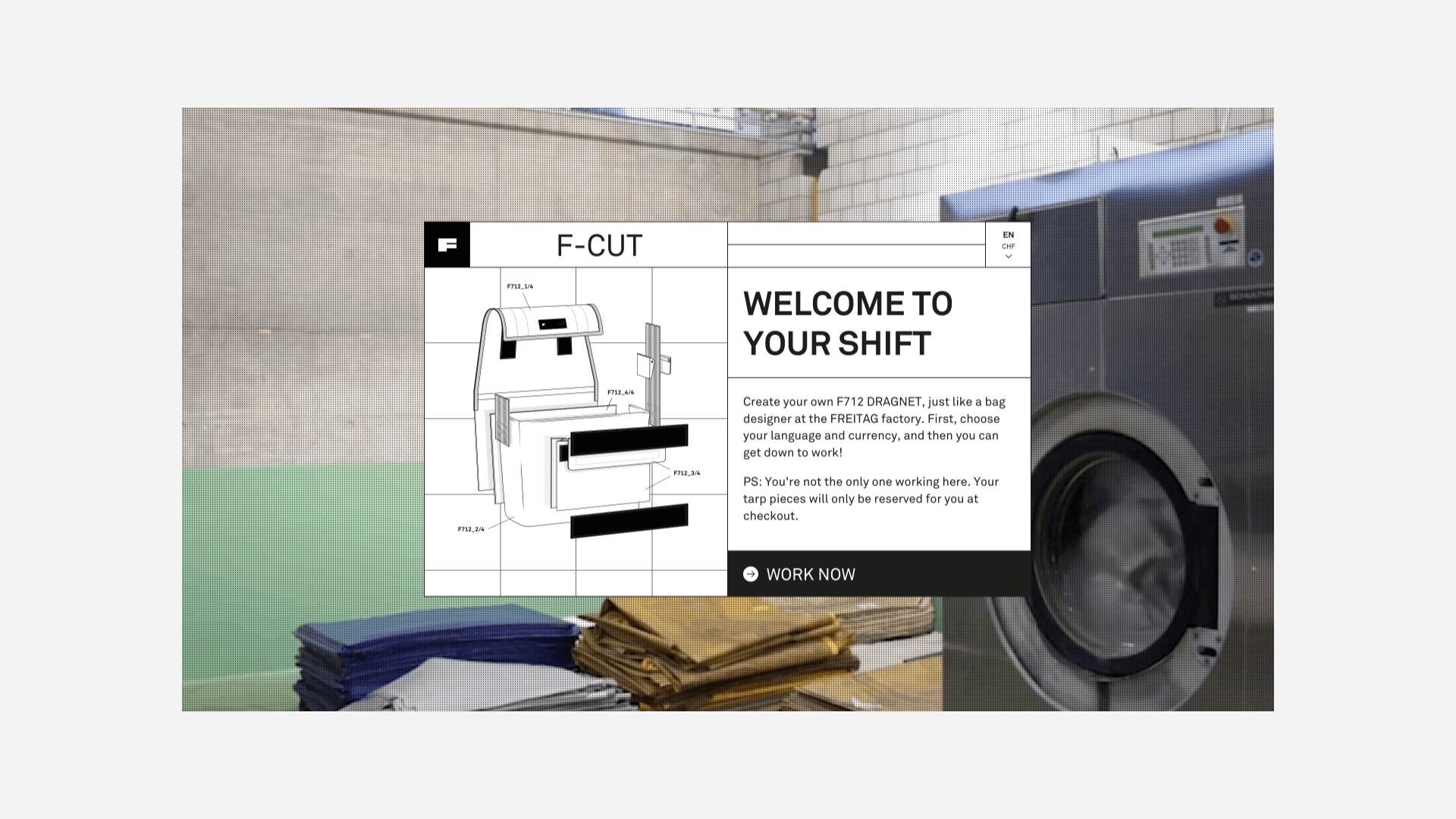
The sustainable Swiss brand FREITAG, known for their bags and accessories made from used truck tarpaulins, has always stood for individualism. With the new digital tool F-Cut, FREITAG now offers its customers the opportunity to design their very own super unique items. The idea behind it was born 20 years ago – and comes from a DEPT® employee.
Desire for more uniqueness
Each of the approximately 300,000 FREITAG bags and accessories produced each year is unique. A large proportion is manufactured in Zurich, where the truck tarpaulins are dismantled and washed by FREITAG employees before the bag designers cut out the best motifs with their cutter knives and templates and these are then processed into bags.
So far, so good. But more and more often, customers inquire in the FREITAG stores whether a specific bag is also available in another color, with this or that motif. The bag makers have taken these requests for (even) more uniqueness to heart – and fell back on the diploma thesis in which DEPT® employee Severin Klaus invented, designed and programmed the first F-Cut for FREITAG 20 years ago.
Democratisation of bag design
The DEPT® team in Switzerland has been working with FREITAG since 2020 and has, among other things, implemented a bag swapping campaign on Tinder for the brand. Now FREITAG approached us to awaken the online cutting table F-Cut from its slumber together with bag and UX designers, logisticians and many other experts.
The following positioning and visions were defined in a preliminary project:
Democratisation of bag design
Every interested customer should have the opportunity to design their own unique bag according to their own taste, beyond all design guidelines.
Bringing FREITAG’s values to life
Sustainability and individualism come first. The FREITAG Sweat-Yourself-Shops are to be transported from the physical to the digital world by means of F-Cut.
Revival of a classic
The new F-Cut is to be as good as the multiple award-winning 20-year-old original, but even more user-friendly and contemporary.
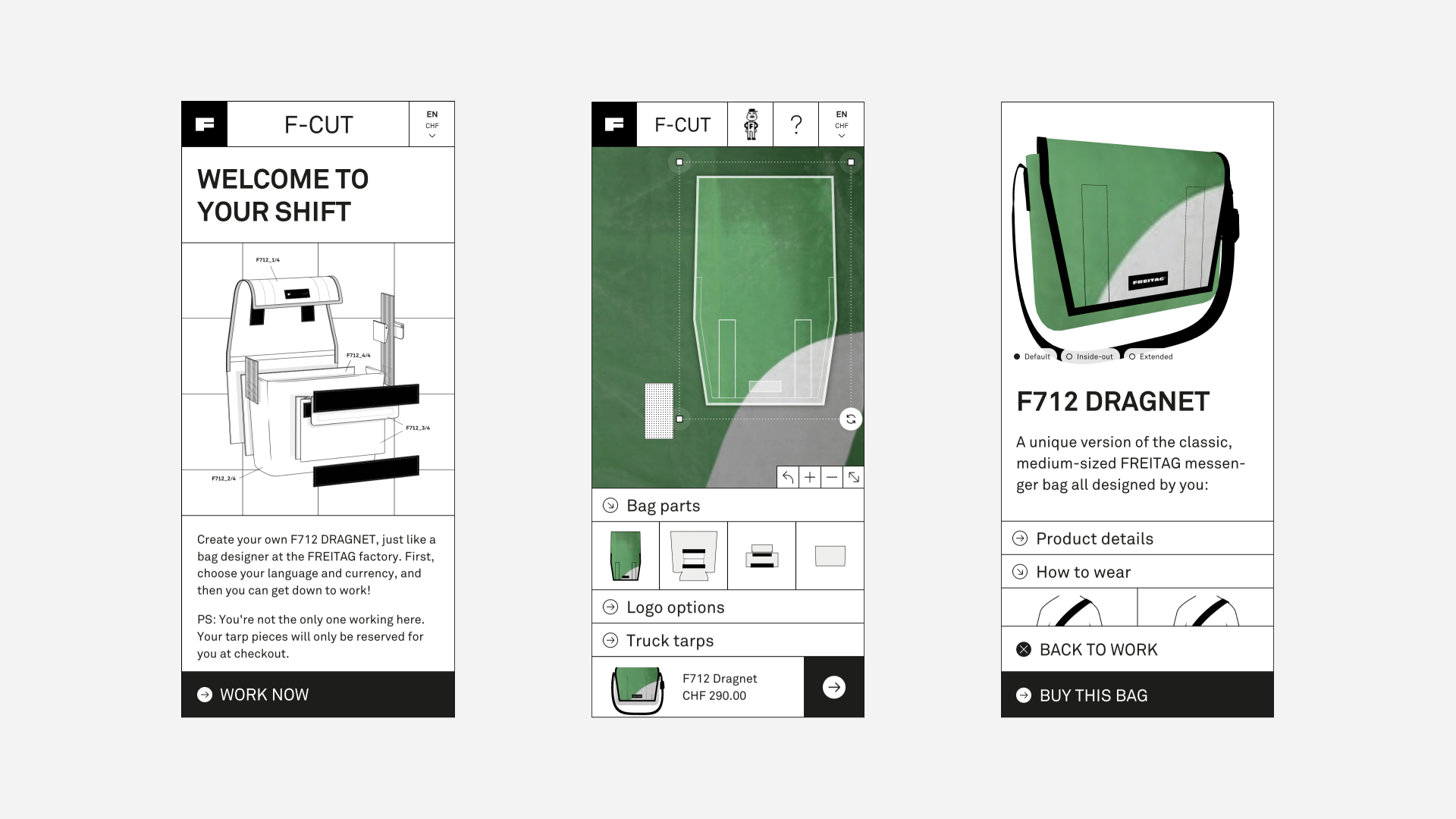
Linking the offline world with the online world
F-Cut offers a unique combination of rough & real materials with digital perfection and a smooth product configuration – no matter on which device, including 3D preview in real time. In this way, the offline world of FREITAG is linked to the online world thanks to a unique experience.
For F-Cut, DEPT® not only implemented the UX, UI and the 3D preview, but also the back- and frontend. The visual identity, creative direction and copy were done by FREITAG.
From a technical perspective, F-Cut is a web application that combines various systems. On the one hand, there is of course the F-Cut app – the GUI – in which FREITAG customers configure their bags. Then there is the F-Cut backend with a headless CMS, which primarily provides a database and communicates via API with the checkout (FREITAG online store) and of course the F-Cut app. In addition, there are further admin interfaces with everyday tarpaulin management functions (configuration, orders, etc.) and tarpaulin upload, editor and export (DXF) for production.
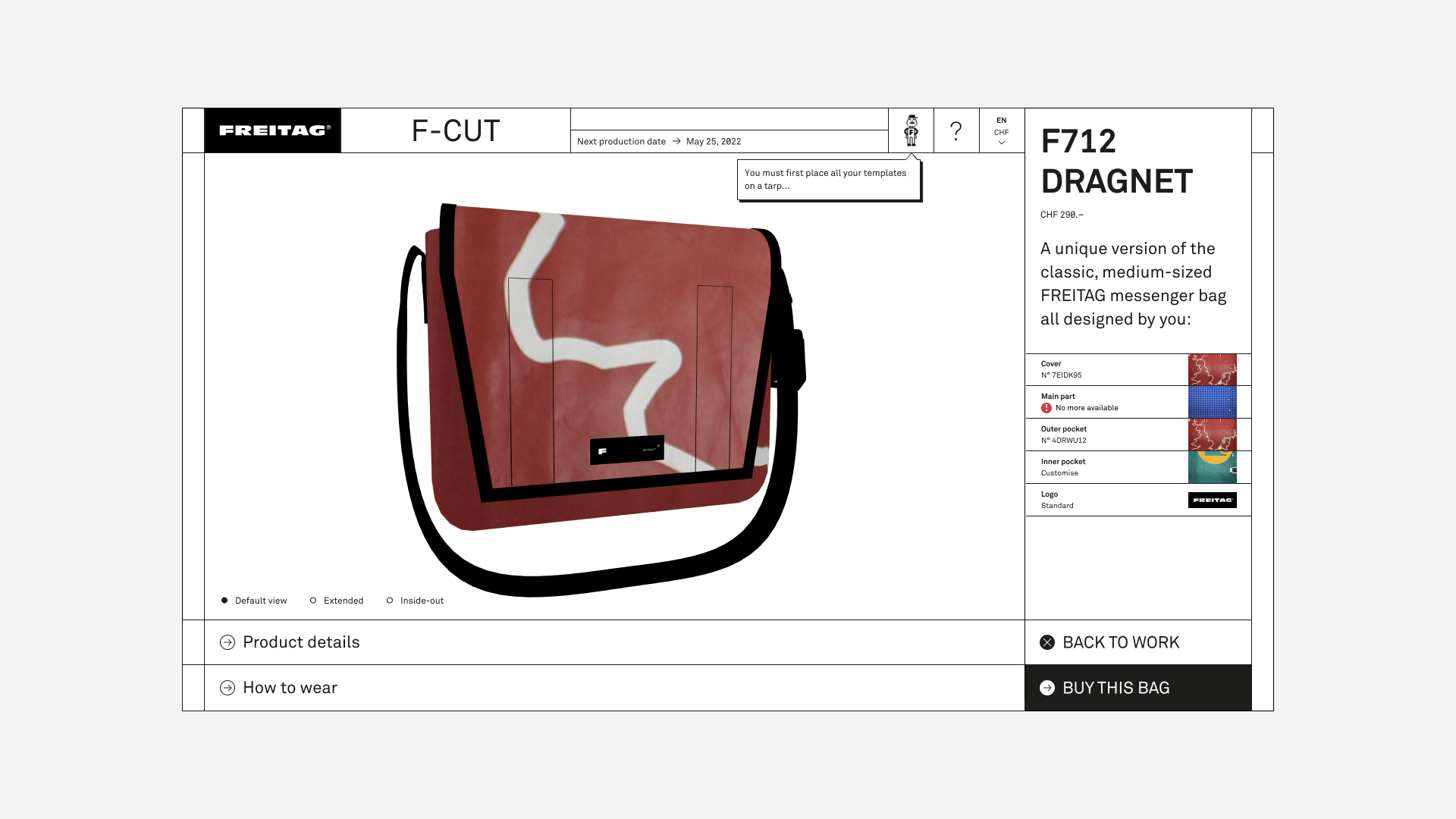
Bag dreams come true
For the first release, the focus was on the KISS principle (Keep It Simple, Stupid): we limited ourselves to one bag type, the Messenger Bag F712 DRAGNET, which can be designed using four virtual templates from a selection of 20-50 different truck tarps. The designable bag types could be expanded in the future or the bag type could change at fixed intervals.
In order to ensure fairness and equality, new tarpaulins are silently added to the system to exclude disputes about the “good” tarpaulin pieces. Another important aspect for FREITAG was the balance between maximum design freedom and sustainability: leftover tarpaulins are used for accessory products.

A few numbers
The response to the F-Cut has been overwhelming, especially from Japan, Germany and FREITAG’s home market Switzerland.
- The virtual cutting table is very busy – between 40-60 users at a time are designing their own F712 DRAGNET Messenger Bag online every day.
- Since the launch in May 2022, more than 300 digitised truck tarpaulins have been used.
- In addition, FREITAG also received many requests from their fans to introduce F-Cut for other bag models as well.
What’s next?
Already before the go-live, F-Cut triggered enthusiasm both among the DEPT® and FREITAG teams. Several further development projects are already planned: more products and features are to follow. 20 years after the birth of the idea, F-Cut has finally awoken from its slumber and will continue to grow steadily.
Over 20 years ago, I got to implement F-Cut as a student one-man show – to rethink this project now, with the support of a fantastic team, both on the DEPT® side and on the customer side, while exploiting the possibilities of today’s technology, is a great privilege.
Severin Klaus, Tech Director, DEPT®
commercetools
commercetools is a headless e-commerce platform which provides the building blocks for the new digital commerce age.
3
Years of experience
4
commercetools cases
Headless commerce platform
It allows brands to build and enrich their online shopping experience. With microservices and APIs, commercetools provides the speed and flexibility that today’s digital world demands. As a commercetools partner, DEPT® is equipped to help companies implement and use this software.
commercetools can be seen as a pioneer in the field of microservices. These include all e-commerce functionalities, such as PIM, cart and order management, marketing and promotions, payments and internationalisation. A flexible and fast API connects these services to all relevant frontends and applications such as webshops, mobile apps, voice, AR/VR applications and social networks. The following four themes are central to the choice of commercial tools:
Microservices
Functionality is developed in a modular way in which each function can be used and developed separately.
API first principle
More than 300 APIs unlock all kinds of functionalities one could desire.
Cloud-Native
commercetools runs entirely in the cloud, guaranteeing IT performance, scalability and security.
Headless
The focus of commercetools is on creating the functional commerce building blocks for your webshop.
DEPT® partners with Bloomreach, Contentful and Magnolia and offers standard integration for commercetools. Thanks to the ‘API First’ principle, commercetools can work efficiently with any front-end solution. As commercetools expert, DEPT® also has experience with integrating other solutions such as Adobe and Drupal.
commercetools cases
DEPT® has supported a wide range of companies with the implementation and usage of commercetools. The following practical examples show how commercetools can take your e-commerce to the next level:
- Eurail.com was looking for a future-proof solution which made it possible to build personal experiences with rich content, implement new functionalities quickly and swiftly respond to changes in the market. We used both commercetools and Adobe Experience Manager to make this a reality. You can read more about the case here.
- Goudsmit Magnetics is an international manufacturer of magnetic systems. Digital transformation is very important here for the long term and Goudsmit defined a new digital strategy together with DEPT®. Based on commercial tools and Magnolia CMS, DEPT® then created for the company a new online platform.
- Holland & Barrett – At the end of 2018, Holland & Barrett, a Dutch chain of health food shops, chose DEPT® as their e-commerce partner. Their new global platform was built using commercetools in combination with Magnolia CMS.
Our Clients




We value a great working relationship with our clients above all else. It’s why many of them have worked with us for years as their trusted partner.
Approach
Talk to us about commercetools
BloomReach
DEPT® is a BloomReach implementation partner working with the BloomReach Digital Experience (DX) platform (Hippo).
An open & intelligent platform
We help enterprises accelerate their business with an agile, Java-based CMS solution and an open and intelligent DX platform.
Our certified developers can work with global companies with diverse digital requirements to migrate to a DX platform that integrates quickly into their current architecture. Taking full advantage of the BloomReach Hippo DX cloud architecture, open APIs, multilingual support, personalisation capabilities, A/B testing, and trend analytics, we can help businesses to control, measure, and optimise the enterprise digital experience across all digital channels and global touchpoints.
BloomReach’s DXP leverages a “headless CMS” approach”, which separates the content and presentation layer to allow you to reuse content and services across multiple environments more easily. Based on the insights Bloomreach-Hippo gives you about the content performance, you are able to create and optimise personalised multilingual content which matches your audience expectations.
DEPT®’s expertise in experience design, extensible architecture, and technology integration can develop a BloomReach Hippo DX solution that gives your businesses the power to deliver personalised content for every visitor, in any context and on any device.
Talk to us about BloomReach
Global SVP Technology & Engineering
Jonathan Whiteside
Whether you’re coming at consumer-facing Whether you’re coming at consumer-facing commerce as a fresh face or are well versed in the sector, researching the available platforms is vital in making an informed decision about which platform is right for your business. For any company looking to understand more about the commerce platform market, the Forrester Wave reports are an invaluable resource. The Forrester Wave™: B2C Commerce Suites, Q2 2020 evaluates each platform across thirty-one criteria to assess the strengths and weaknesses of each available platform and analyses the trends developing in the industry at large.
This is particularly important as there is no single ‘must-have’ platform. The commerce platform sector has plenty of entrants and sees constant innovation, creating a marketplace that is both highly specialised and broad. Because of this, businesses must take a tech agnostic approach and review each of the available options when considering a new B2C platform. This makes it possible to match the various benefits of each vendor with your business’s key needs and aims, rather than choosing a market leader from the outset and trying to fit a square peg in a round hole. To begin the process, here are a few important points and questions to consider.
3 key considerations
Early on in the process of choosing a vendor, it’s important to consider three types of ease:
- How easy is it to integrate the platform into your existing tech stack?
- How easy is the platform to use?
- How easy is the platform to update/upgrade?
These three factors are at the core of your experience of the platform. Any complications in these areas and the business may not be able to maximise its investment in the selected solution.
Aware of the difficulties of integration, there’s been a trend in the industry towards out-the-box B2C commerce platforms, offering sellers a simple route to market with the added benefit of architecture that has been proven to work by other online stores. For companies with a more complex offering, or those looking to make use of a wide array of additional features, finding out more about the integration of each add-on and custom feature is a must. The right platform should fit your digital roadmap, catering to your current needs and future aims.
Ease of use
When considering the ease of use, there are two areas to focus on. The first is external – what kind of educational and instructional material does the vendor provide? This could come in the form of knowledge-share resources, 24/7 online support, or scheduled training sessions. This offering varies, and each business will have a different preference for how educational and instructional information is provided. Equally, if a commerce platform requires extensive training to get up-to-speed, it may not be the right fit. If the priority is getting a B2C platform up and running quickly, the time it takes to learn how the service works is an important factor to consider.
When considering ease of use, think of how various processes can be managed through one platform, rather than a series of siloed solutions. For a diversified tech stack, this means building a unified user interface, where possible, to prevent hopping between interfaces.
The second is internal – how does the platform fit with the expertise of your in-house development teams? Colleagues may already have experience with a certain platform, which is a useful benefit, particularly for vendors that provide more customisation options. Whether the platform solves the business’s aims is the top priority, but prior experience can be a tie-breaker factor when choosing a platform.
Updates & upgrades
Businesses that are new to commerce platforms can often overlook the update and upgrade process. Some updates can cause downtime, something that no e-commerce site wants. Additionally, upgrades and updates can be costly and slow down the adoption of new features, requiring a complete platform update to use a new feature.
In the past, tech providers offered annual and quarterly updates to the service, however, this is changing as each vendor looks to keep up with the speed of innovation in the sector and provide regular updates.
While the sector is trending towards continuous deployment and no downtime models, be sure to speak to vendors about their update and upgrade process to ensure that the e-commerce site will be able to avoid downtime wherever possible, and stay up-to-date with the latest developments in e-commerce.
B2C commerce suites
When selecting a platform, it’s always important to choose the right option for your business’s needs, not just the market-leading option. Features differ, specialisation differs, the design differs. Below, we have assembled DEPT®’s collected thinking and a number of case studies to provide more of an understanding of a selected number of platforms to consider when looking for an e-commerce service.
Salesforce Commerce Cloud
Salesforce’s strength lies in personalisation and AI-powered decision making. Building an e-commerce site is simple through the Page Designer tool, a feature of Salesforce Commerce Cloud that makes it easy for marketing departments to create content pages in a user-friendly environment. Page Designer’s ease of use makes it an ideal feature for companies looking to frequently create new product pages and in-house the building of new pages, following the initial implementation. Saving time this way is a major benefit for companies that want to be up and running as soon as possible.
Working with Bugaboo and using Salesforce Commerce Cloud, DEPT® built and launched the pushchair brand’s new site in 26 countries in just four months. The initial build is the first step, with potential in the future to improve the shopper experience with 3D product models on each page and the ability to share custom products.

Episerver Commerce Cloud
In the B2C commerce market, Episerver stands out as a digital experience-focused offering for mid to large-sized enterprises. Plenty of personalisation features facilitate relevant shopping experiences for each shopper, and the level of custom configuration make it a popular platform for many developers.
There are plenty of API possibilities through Episerver, including the use of headless commerce, putting Episerver users in a strong position for the future of e-commerce and making the expansion of e-commerce options to new services, like voice assistants and smart wearables, a much simpler task.
Commercetools
Commercetools pride themselves on their API first principle; more than 300 available APIs unlock hundreds of different functions for businesses to consider, across websites, social media, mobile apps, VR/AR experiences and voice assistants. This naturally builds into a headless approach.
The Commercetools approach centres squarely on e-commerce activation, making it a useful fit for companies that are already happily settled with their current CMS system, as shown in DEPT®’s work with Eurail.com. This project integrated Adobe Experience Manager and Commercetools to fast track the success of the train ticket site through an out of the box solution.
Shopify
Shopify stands out from the market by targeting small to midsize independent retailers, rather than large enterprises. Shopify’s platform is focused on growth, opening doors for retailers with a limited number of stores to grow online. This is supported by the recently launched Shop app, a marketplace for all stores that use Shopify as a commerce platform, boosting discovery.
The Shopify Plus option provides deeper levels of automation through a number of add-on applications, as well as headless commerce. AR product pages are also an option, allowing smaller businesses to create a shopping experience that rivals the major players in their industry.
Getting started…
There is a broad spectrum of platforms to consider, the above examples are just a small cross-section of the various available suites. Manoeuvring through this market requires a clear view of what your business needs and a deeper understanding of how each option fits (and doesn’t fit) the key aims of the company.
Do your own research, read recent reports and material published by each platform, and start conversations with platform vendors and possible partners. This is an evolving process; it can take time to become conversant with the market, but it begins with the first step. If you need any advice, DEPT®’s commerce technology experts would be happy to help you.
More Insights?
View all InsightsQuestions?
Global SVP Technology & Engineering
Jonathan Whiteside
The process of building an e-commerce platform can seem like new ground to many B2B CEOs. Understanding the array of software options on the market, learning new phrases like ‘headless commerce’, being able to distinguish between a CMS and a DXP. These surface-level barriers can scare some away, but by digging a little deeper, every company head will find themselves in familiar territory.
A successful B2B commerce platform is built on an in-depth understanding of the customer. Awareness of customer needs. Knowing what causes friction in the purchasing process and how to work around it. The leadership team are experts in their industry and know what makes their customer base tick. By stripping away the excessive acronyms and complicated definitions, B2B commerce comes down to knowing what customers need.
At its very core, digital transformation is about making your company’s assets go further. Can the innovative thinking of the leadership team be implemented quicker? Can insights gathered from customer data be applied to other areas of the business? Can consumers be given an easier path to purchase? Digital transformation magnifies strengths by focusing on scalable improvements.
Brenntag: building a digital chemical business
For Brenntag, a German chemical distributor operating in 76 countries, implementing a digital transformation began with an appreciation of their industry. Brenntag’s world, the chemical sector, is heavily physical. However, digital transformation touches on each aspect of the business. At every turn, innovative digital approaches could be used to optimise and improve the efficiency of internal processes and ease the experience of customers.
The process of digital transformation was split along internal and external improvements that could be made. Working with DEPT®, the company put together a system of Internal Tooling that set out to improve the efficiency of their every day, internal processes. This includes features like Brenntag Source, an application for reviewing supply chain data.
Use existing supply chain data to help your clients.
The Brenntag Source feature can be used to filter data on different suppliers, giving Brenntag the information they need to engage in informed face-to-face negotiations with suppliers.
For the customer, this information can be turned into tracking software, keeping the buyer updated about the delivery of their purchase, and also informed about the sourcing, materials and manufacturing of their order. Good customer experience is what drives repeat purchasing, particularly in the manufacturing sector where trust is a key business driver. This added value can be what sets the company apart from its competition, as it puts the customer at the centre of the process, answering every question they may have.
On the external side, Brenntag Connect was created, an e-commerce portal that provides customers with information on the chemicals and orders that Brenntag provides, as well as a platform to track their security data, invoices and orders.
Make repeat purchasing a top priority
When planning a B2B commerce platform, it is important to think of the sector-specific rules that affect how it can be used. Due to the regulated nature of the chemical industry, Brenntag Connect is only available for customers that have gone through an intensive onboarding process. This means that users of the platform are likely to be committed, long term customers, therefore making repeat purchasing easy was a top priority. To this end, Brenntag implemented an automated repeat business function.
One of the key challenges for any commerce platform project is to establish a long term strategy. To start putting a system like this in place, put together a list of needs that the platform must fulfil. From this information, build a digital roadmap that outlines the steps your business will take over the next three years, each time responding to a customer need.
Digital transformation is a step-by-step journey, not an overnight makeover. By beginning with priority areas based on customer needs, your company can start serving customers better and begin the process of learning and adapting your e-commerce approach.
Like any map, the route is liable to change based on real-time information. Data capture is a core need for any project, informing and ensuring that the decisions and actions taken are correct. What we measure, we can affect. In terms of a digital roadmap, see the data as you would see live traffic updates. Be ready to get past roadblocks by adapting the route.
To keep their digital transformation on track and ensure, Brenntag built DigiB, a digital innovation hub that operates autonomously from Brenntag. The organisation aims to rapidly accelerate their technological innovation across the business, running small scale projects that have the potential to scale, and aiding the implementation as Brenntag finds new, more efficient ways of operating.
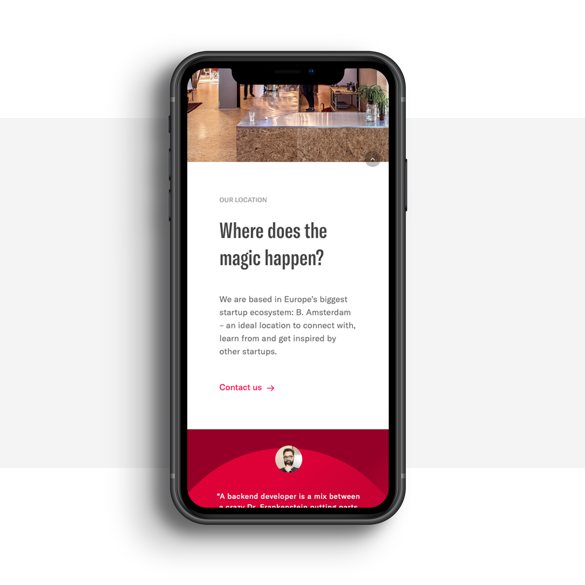
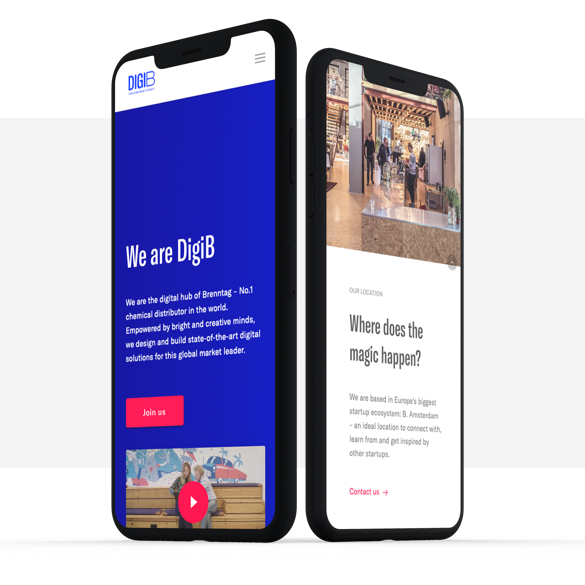
The guiding motto of DigiB is “create it, launch it, learn from it.” Rather than taking the time to perfect every single release, adding months to the lead time, DigiB focuses on putting new projects into the marketplace. Release a smaller scale project. If it works, scale it up, if it doesn’t, take a step back and learn from the problems that users experienced. This way, every project is a worthwhile endeavour, creating a ‘succeed or learn’ mentality that fosters a strong corporate mentality.
Being able to create a company-wide culture that believes in the digital transformation project matters, as each department is able to offer input on how the key business goals can be achieved. Sales teams will be speaking to current and potential customers day in, day out. Operational teams will be using the internal tools each day, able to give feedback on what works and what is still missing.
Each business will have a different priority when it comes to building a B2B e-commerce platform. This depends on the customer needs in each sector and any pressures that are placed on the business by industry regulations. The list below looks at some of the most common priorities, though each business is different.
Making product discovery clear and simple
Companies with a wide array of available products or services will benefit from making sure that the site is built to provide easy-to-understand information on each product. On each product page, aim to answer any question the customer could have; keeping the customer on the product page means more proximity to the checkout.
Easy product discovery also means clear categorisation of products. Many B2B suppliers and distributors provide highly specialised products; it is the company’s responsibility to make finding the appropriate specialised product simple. The less friction in the buyer’s journey, the more likely they are to purchase.
Establishing site search
An undervalued benefit of building an e-commerce platform, site search is an obvious boost to user experience, but also an important data gathering tool. For many visitors, site search is how they engage with the site. It’s the bridge between each page, expediting the process of finding a product to buy. In terms of user experience, various features can be implemented to aid their search, such as autofill, search correction suggestions, and the ability to filter results. For visitors that are used to the features offered by Google, these additions to site search are less an added bonus and more of an expectation.
With site search implemented, make sure to review the analytics software to follow the journeys that users take around the site. Each business spends a good chunk of time trying to understand buyer journeys; this feature gives users the ability to track each journey to purchase.
By putting an advanced search tool in place, your business is able to see the key information that customers gravitate towards. It also Indicates missing content that the business should create – the questions customers are asking but not finding the answer to. The business can also see which additional purchases are considered, but not added to the basket, showing potential sales activations to use. Working with Omron, DEPT® used site search analytics and the onsite tracking software Hotjar to see how the architecture of the site was impeding users from checking out.
Putting all this together, the information can be used to provide a much more personalised experience for each visitor. Personalising the shopping experience boosts e-commerce sales, in DEPT®’s ‘What Do Consumers Really Think Of Personalisation?’ study, we found that 38% of consumers would spend more if a brand uses personalisation relevant to their needs. For Omron, this resulted in a tailored experience based on whether the visitor self-identified as a distributor, a system integrator, an employee, an end-user, or a member of the press. Giving the appropriate information led to a 20% fall in bounce rate and a doubling of the average number of pages visited per session.
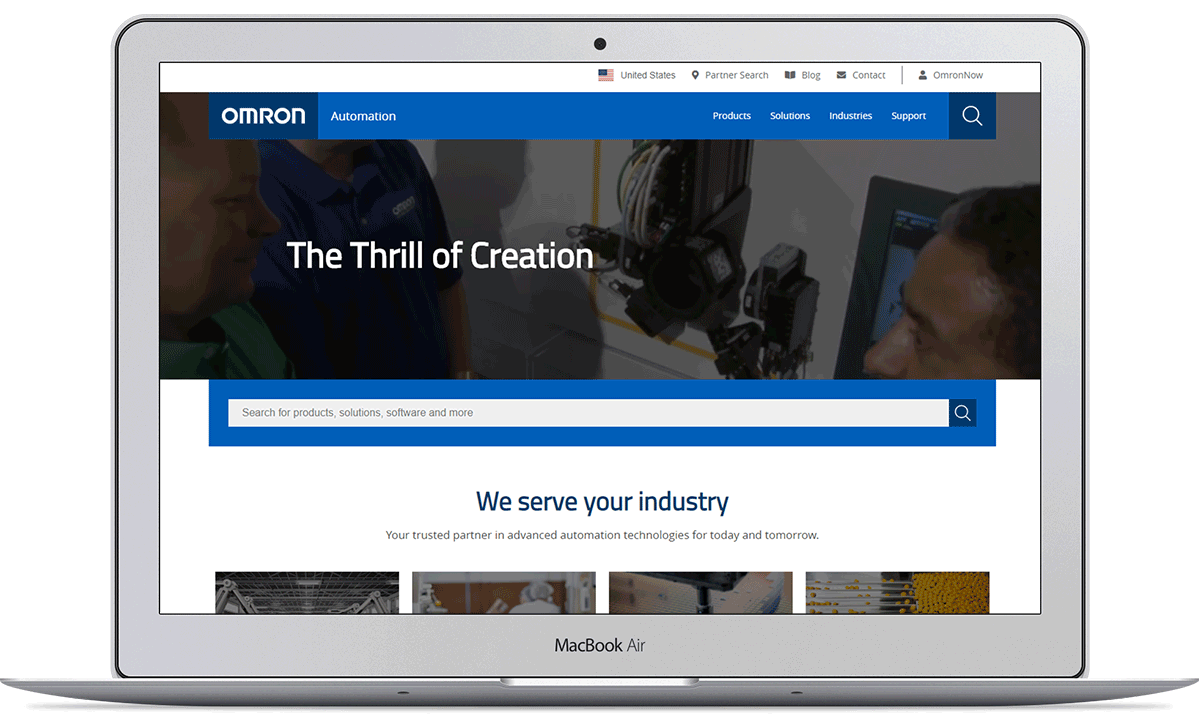
Logistics, lead time and availabilty
For a B2B commerce platform, providing detailed information on the manufacturing, shipping and delivery time is a key addition. Availability too, as nothing is more frustrating than finding the right product only to see it’s unavailable. This information is vital to future planning. It helps the customer plan their purchases and ensures they fit the time scale of their project. In an increasingly eco-conscious economy, being able to review shipping options and sourcing of products also allows the company to make the right decision based on environmental impact.
As a B2B supplier, think of the common questions that customers would ask, and that your business would ask of a supplier. Aim not only to answer these queries but to make the answers highly visible and in close proximity to the purchase.
Product comparison
For suppliers that offer a wide range of similar products, particularly those that specialise in a particular niche, giving site visitors the ability to compare products is an important benefit. Not only can they compare in detail each product, but they are also more likely to make the right purchase, boosting their opinion of the brand and making the customer more likely to return.
Crawl, walk, run
Whether your business is highly fluent in digital projects or new to the space, the journey to running a market-leading e-commerce platform begins with the first step. Rather than aiming to release the perfect platform, begin with agile projects. Focus on making an impact sooner rather than later and seeing what can be proved and what can be learned. Steady rollout of further features will create a system of constant improvement, always aiming to iterate and optimise. Each success will be reflected by customer sales and preference for your business.
More Insights?
View all InsightsQuestions?
Managing Director Digital Marketing







